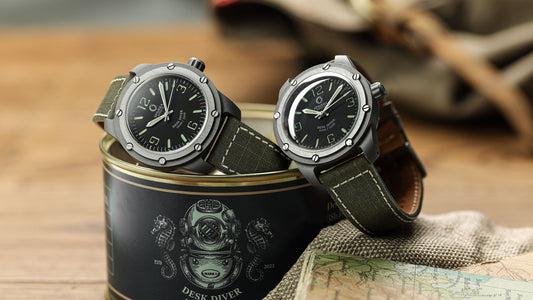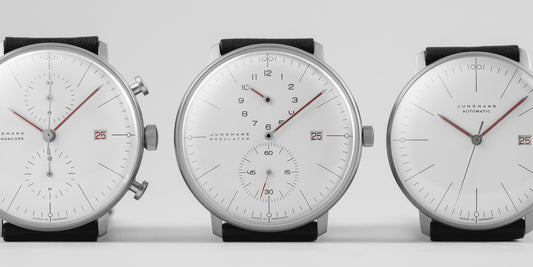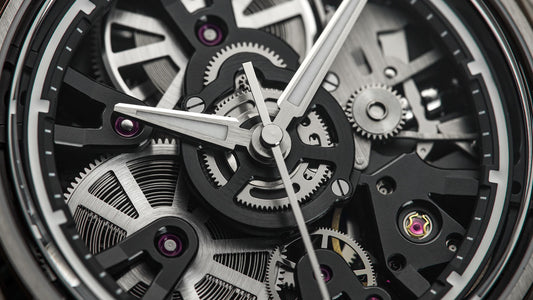Ever needed to know anything about the EZM1? Look no further...
There are many brand-defining watches out there. Ones that, given the outline, the dial design or just a few details, most watch collectors could identify the watch. Think of the bezel edge on a Rolex Sub, the perfectly oriented screws holding down the bezel on a Royal Oak, the skeleton hands on a Seamaster Pro or the square case of a Monaco. Sinn used to be a small brand, started by a retired Luftwaffe pilot keen to offer capable watches to professionals that needed and relied on accurate timing in their daily lives.
59 years after its foundation, Sinn is a much larger brand, with global reach, and a model range that covers many bases. They have a robust attitude to innovating and improving their offer to an ever more discerning marketplace, and this continues to bring them fans and customers worldwide. They have made innovations in case design, waterproofing, oil-filling of watches, and now movements too.
I think that there is, above any other, one watch that cemented the Sinn reputation and elevated the company from journeymen to craftsmen in the eyes of the watch world. Sinn’s brand-defining model...
The Origins of the Sinn EZM1
The EZM is a very unique acronym for a very unpronounceable German phrase, Einsatzzeitmesser. It means Mission Timer, although not being a linguist I am a little flummoxed how smooshing the words for Commitment, Time and Knife together gets to mean Mission Timer. I digress.Sinn have now produced 16 different model ranges under the EZM banner, but the 1 was clearly first.
The watch was specifically developed in partnership between Sinn and the commanding officer of the ZUZ unit, an elite armed force within the German customs authority, Zoll. The OIC wanted an operational timepiece to issue to his teams. It was designed and supplied to them back in 1997 in tiny numbers, 25 at most.
The brief was clear, a highly water-resistant chronograph of utmost legibility, day and night.
But this design was not started on a clean sheet of paper. From their founding in the 1960s Sinn always had a very derivative leaning to their work, understandable as that they didn’t start as a manufacturer, but an assembler of bought-in components, externally designed and made.
An example. One of Sinn’s most successful early models, the 140 and 142 (which used the Lemania 1340 and 5012/5100 movements respectively, in the same case) was in fact not a Sinn design at all, it used a case that was also offered by Lemania themselves, Nivada, Richard, Sicura, Alpina, Bucherer, Dugena, and Rodania as well as promotional watches carrying the names of car and tobacco companies.
Sinn also used to be a service agent for the Heuer Bund chronographs, in and after their service to the Luftwaffe, and Heuer clearly provided a lot of “inspiration” for Sinn’s early designs. Here are some examples
• Sinn 150 = Heuer Silverstone (the Lemania -powered version)
• Sinn 155 / 156 / 1550 / 256 = Heuer Bund
• Sinn 157 = Heuer AMI
The Design of the EZM1

The Sinn EZM1 - Image Credit: Dave Sweeting
So, Sinn started The EZM1 design by commandeering one of their other cases, a very traditional one based quite closely on an EPSA (Ervin Piquerez SA) compressor case from the 1960s.
The original design had also found use by Heuer in the late 1960s for the Autavia 7863C and later 2446C, by Breguet for the Type 20, and several other models. A 40mm diameter round case, it has very distinctive tapering lugs that chamfer at the end, and have large external chamfers to the top surfaces. Sinn was inspired by this design to produce one of the first Sinn chronograph cases, called the 103, and they rolled out the same case again for the EZM1. (Incidentally, Sinn still love this case design, it is in use today for all the current 103, 104 and 206 ranges as a 3-hand and chronograph watch case). This case also has a bezel, providing more functionality, with a 60-minute countdown scale for the EZM1. But there were changes in the case for the specialist requirements paid out by ZUZ. Several in fact. The first was the movement, the Lemania 5100. We’ll get back to that later. Next, the material. This was not to be made of steel, but titanium, for every part, including bracelet and bezel. The Ti made this watch impressively light, only 61g for the head, without strap. The blasted finish also lends the watch a purposeful or tactical appearance.
Sinn added in some of their most recent innovations. The case includes a Copper Sulphate capsule, with an external window. The Sulphate is hyrgroscopic, so any moisture that finds its way into the watch case is absorbed into the crystals, keeping it away from the movement. Even more impressively, The Sulphate changes colour from near white in its anhydrous state, to a deep blue as it scavenges the moisture. This colour shows through the window, providing a tell-tale that the watch has leaked and needs attention, even whilst allowing the watch to carry on operating. And the watch case itself is filled with inert gas, to avoid any moisture present in ambient air, and corrosion in the presence of moisture with oxygen. This gas was Argon when the system was first invented and used on the EZM1, but Sinn has since changed over to Nitrogen as the inert fill. The case sealing system was fettled too and a water resistance rating of 300m was achieved without needing screw-down pushers that might inhibit the use of the chronograph.

The Sinn EZM1 - Image Credit: Dave Sweeting
Lastly, and very recognisably, they reversed the case from its traditional orientation. With pushers and crown on the left, a normal left-wrist-wearing user doesn’t have any of these features digging into the back of their hand, and the controls are not hit by anything in the user’s hand. The chronograph is started, stopped and reset as normal, but using the thumb of the right hand, not the index finger. It is a very intuitive action.
To aid legibility, the dial design was pared down to minimal simplicity. It is clear that the Omega Ploprof provided the base architecture for the linear indices, but Sinn went even further, making the brand and date dark red so that they didn’t interfere with the simple white on black legibility. Up until this time many of Sinn’s watch dials had numerals everywhere. Hour numerals, a tachymeter scale, sub-dial numerals and so forth. The EZM1 did away with all of them, except the date.
The choice of the Lemania 5100 was obvious, Sinn had been using it for years and the central minutes (as well as seconds) on the chronograph provide ultimate legibility, as both scales are read on the main dial, rather than minutes being squashed into a sub-dial. The 5100 had an impressive specification in military use as well, especially in Germany, where Porsche Design, Tutima, Arctos and Tengler all used it in Bund-issued watches. It is robust and shock-resistant, the nearest thing to quartz reliability that mechanical movements can provide. The “innovation” here was to strip every other feature from the watch. No running seconds. No day/night indicator at 12. No day, and no 12-hr register at 6 either.

The Sinn EZM1 - Image Credit: Dave Sweeting
The user is left with 4 central hands, easily distinguished, and a date minimised to the point of invisibility. All of those hands are also very brightly lumed, so the chronograph can be read in the dark as well as the time. And that was it. Just like the EZM moniker, the watch was a recipe of features smooshed into one. A 1960s-inspired chronograph case. A 1970s diver dial. A well-proven military-grade chronograph movement stripped of all unnecessary features and a sprinkling of innovative technology.
It doesn’t necessarily seem, on the surface, to look like a particularly compelling combination. And yet the design elements sit together very well. Despite its early origins, the case, in blasted titanium, doesn’t look vintage or derivative, it looks modern and crisp. The dial compliments that with minimal indices, and purposeful dark red branding.
The design just works. What is more, it also looks original, hiding its derivative origins with aplomb. And it was unique. No other chronograph had this stripped functionality, this clean look, this level of water resistance, night-time legibility and such an impressive list of technical innovations.
Sinn clearly realised they had a winner on their hands, and launched the model to the public soon after its delivery to the ZUZ, in 1998.
Production
It was a success, and despite being one of their most expensive models, Sinn produced about 3100 of these for the civilian market, until a bombshell dropped 4 years after launch. The Swatch Group, who owned Lemania, ordered them not to sell their movements to watch companies outside the group. The reason is that the Swatch Group also owned Breguet, one of watchmaking’s most prestigious names, and they had identified the Lemania factory as the perfect place to convert into a new Breguet Manufactory. As such, it wouldn’t be able to continue to produce movements for others. Breguet are still based in the Lemania building in l’Orient today.There was no alternative movement that could be used. Sinn and a few others like Tutima, were given the last opportunity to buy movements for stock, and then supply ceased. Movement supply stopped in 2002, affecting all of the other Sinn models that used the 5100, like the 142, 156 and EZM4. The last EZM1s were cased up and sold by 2004 or thereabouts.
Limited Editions
A while later in 2008, keen to re-create their success, Sinn secured another batch of Lemania movements (possibly from Tutima, we are not sure), and made an EZM1 Limited Edition of 250, each example having its own number on the case side. The design was almost totally unchanged, apart from minor bezel details.
Such was the clamour for these watches, the LE sold out within minutes of the announcement, and examples traded at a considerable premium from the start. I cannot find the list price, but it was under £1500, as one of my near neighbours managed to get one.
Back when Lemania movement supply stopped, Sinn almost immediately announced the in-house development of the SZ01 movement, which would be based on the Valjoux 7750, but would copy the central minute display of the Lemania 5100 that they so clearly missed.
It took 9 years to perfect, and only in 2012 did the EZM10 finally debut Sinn’s new movement.

The Sinn EZM1 - Image Credit: Dave Sweeting
Tutima have also done similar, as have Damasko. There are other modules available now as well that mimic the central minute clarity of the Lemania movement. It is clearly a feature that many manufacturers want to have in their chronographs.
Sinn’s Valjoux-derived SZ01 movement was used for the last of the EZM1 offerings to date, the EZM1.1 LE from 2018. A single batch of 500 units this time, it looked the same as the original, but the size had grown from 40mm to 43, and the watch now weighed 106g without the strap. It also cost a bit more, about £4000. As a result of the changed specification and cost increase, this LE took a while longer to sell out, and now trades at prices below the original.
My personal EZM1
My own EZM1 is one of the last of the original production, with a serial number is just over 3000. I bought it in Dec 2008. Just after the first Limited Edition release, prices had started to rise significantly, and I realised that if I was going to own one, I needed to buy before they got out of my reach. I am glad I did. I am not sure I could have called myself a true Lemania collector without having owned one, as it is probably the most technically advanced watch to use Lemania’s last movement before their demise.I have worn it a lot, for a host of different activities, and it has coped well with them all. I had it serviced at Sinn last year, for the first time, and it has functioned perfectly throughout my ownership.
In watch forums, there are regular “if you were only allowed one watch” threads, to see what collectors would consider their most valued or appreciated watch. I think the EZM1 would be my “one”.








